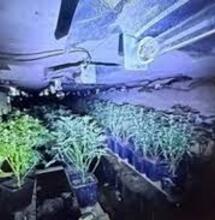Hydro Over Hand Watering Part 4: Aeroponics

It's time to step it up a level and go for the big leagues! Aeroponics is the growing method of choice for cultivating high value crops across the globe, from commercial production for UK supermarkets to small scale production in the NASA space station!
It's time to step it up a level and go for the big leagues! Aeroponics is the growing method of choice for cultivating high value crops across the globe, from commercial production for UK supermarkets to small scale production in the NASA space station!
It's time to step it up a level and go for the big leagues! Aeroponics is the growing method of choice for cultivating high value crops across the globe, from commercial production for UK supermarkets to small scale production in the NASA space station!
Aeroponics may be seen by a percentage of growers as too expensive, complicated or advanced to be considered as a method for growing at home. In reality, the aeroponic systems available to the home grower are straightforward to use and cost little more than any other hydro system.
If you can maintain a nutrient tank, check EC and adjust pH, then you can handle an aeroponic system. Get ready for some monster yields!
| Aeroponic cloners are a great method to propagate clones, fast! |
What is Aeroponics?
Aeroponics is a growing method whereby the roots of a plant are suspended in air and constantly sprayed with a mist of nutrient solution. No growing medium is used, other than a propagation cube if the plant was started from seed, the roots of the plant grow into a chamber or channel where they are fed by misters, sprinklers or spray heads that deliver the nutrient solution via a pump.
Aeroponics can be used to grow plants full cycle and also produces excellent results when used to propagate clones.
Plants that are grown aeroponically have constant access to nutrient solution and oxygen; taking up much more water and nutrients than plants that are hand watered. The more oxygen, water and nutrients that a plant can absorb, the bigger the yields they will produce.
| Healthy aeroponic root development! |
Why Aeroponics over hand watering pots?
• Ultimate speed of growth and massive yields - aeroponic systems offer the maximum possible exposure of plant roots to water, nutrient and oxygen. The more availability of these three key elements the plant has, the faster it will develop and, ultimately, the more it will yield.
• Faster turnaround of harvests - the rapid growth that aeroponics offers, allows growers to shorten the vegetative period of their growth cycle and get more harvests per year.
• Healthy root zone - no growing medium is required whatsoever, this means a reduced risk of soil borne pests and disease.
• Never under-fed or under-watered and no nutrient build up - plant roots have constant exposure to all of the water and nutrient they require, they uptake whatever they need and, in the majority of aeroponic systems, whatever is left drains away rather than building up in the root zone.
| The AeroFlow - aeroponic channel system |
Types of Aeroponic system
Aeroponic Propagators
There are a number of aeroponic propagators on the market and most of them work on the same principle. Designed specifically for clones, growers can benefit from a much improved success rate, as the lack of growing medium used means the propagation environment is kept sterile.
Clones are placed in a tray using neoprene clone collars - some of the propagators available use a mesh pot and a collar - the stems of the clones are suspended underneath the tray, inside a misting chamber and are constantly sprayed with a mist of nutrient solution.
This constant supply of nutrient, water and oxygen, combined with the lack of restrictive growing medium, encourages roots to develop rapidly from the stem of the clone. The fast root development allows you to get your grow started earlier. Clones developed aeroponically will also have stronger, thicker roots that are less prone to transplant shock.
Some of the better aeroponic propagators on the market are supplied with a dome lid that allows you to control the airflow and humidity and harden the clones off before you transplant them on.
| The Amazon - low pressure, recirculating aeroponic system |
Recirculating Low Pressure / Droplet Aeroponics
These systems are readily available from grow shops across the UK and, compared to high pressure systems, are low cost and low maintenance. They use a low pressure water pump to deliver a constant supply of nutrient solution in the form of a spray.
Young plants or rooted clones are placed in mesh pots and suspended in a misting chamber, or channel, that sits on top of a nutrient solution tank. The roots are constantly sprayed with nutrient solution whilst being suspended in air and grow down into the chamber. All of the unused nutrient solution drains back into the tank to prevent nutrient build up, water-logging and potential restriction of oxygen to the roots.
High Pressure / True Aeroponics
Most commercial aeroponic applications involve high pressure aeroponic systems; this is where water and nutrient are delivered to the plant roots via a high pressure pump and misting system or atomiser.
The systems are used to cultivate high value crops - such as lettuce and basil - and, in order to exploit maximum yield, are usually part of a complex set up that monitors and adjusts air and water purification, nutrient sterilisation and environmental conditions.
For domestic cultivation and smaller set ups, high pressure aeroponics can be cost prohibitive and difficult to maintain - high pressure spray heads can become easily blocked if used with concentrated nutrients and additives.
What type of grower is Aeroponics good for?
Aeroponic propagators are spot on for raising clones quickly and easily, ideal for;
• Large scale growers looking for a quick turnaround on clones. Some of the bigger cloners on the market can fit over 100 cuttings and will have them ready for transplant in under 10 days!
• Percy growers, small scale cloners are a perfect fit for a small grow room and can even fit into a small wardrobe or kitchen cupboard. They are suitable for any type of grow, as the clones can be transplanted into any medium or hydro system.
• Growers who have experienced problems raising clones in the past. No growing medium means a sterile root zone, stronger roots and less risk of disease or transplant shock.
Aeroponic growing systems are better suited to smaller scale set ups;
• Percy growers looking for the next level in hydro. For experienced growers looking for bigger yields, aeroponics can offer unrivalled growth rates and those extra ounces that they have been chasing!
• Growers who use an aeroponic propagator, as their plants can be transplanted directly into the system and will ‘take' almost immediately, with little risk of transplant shock.
• Growers who do not have the facility to dispose of lots of soil or coco. The only growing media used is propagation cubes or, if propagated aeroponically, no growing media at all. No bags of waste to throw away after you harvest.
• Sea of Green technique, most aeroponic systems allow plants to be spaced close together and the rapid growth experienced allows the veg period to be cut down to just a few days.
The Three Steps To Aeroponic Heaven!
1. Use an anti blocking agent. Adding an anti blocking agent - like Canna D Block or Atami ATA Clean - to your reservoir will keep things flowing freely. Both high and low pressure aeroponic systems run the risk of the sprayers blocking with nutrient salts.
2. Leave the pump on 24/7. For optimum results, a plant's roots need constant access to water, nutrient and oxygen. Remember that aeroponics is a ‘bare rooted' technique and there is no buffer surrounding the roots. Turning off the pump, even for a short period, could potentially damage them.
3. When propagating clones aeroponically, allow the roots to develop depending on the growing method that they will be transplanted into:
- If transplanting into soil or coco, remove from the propagator after the roots have grown 2 or 3 inches long. Carefully pot up into 3 or 4 inch pots and grow on for a few days before transplanting on into larger pots.
- If transplanting into an aeroponic system, remove from the propagator when abundant roots have grown 3 to 4 inches long and transplant directly into the system.
- A good tip for transplanting into an NFT system is to grow the roots to around 5 inches long and punch a hole in the bottom of a 3 inch rock wool cube, sandwich the clone between two halves of a propagation cube (rock wool or root riot) and place into the 3 inch cube, allowing the roots to trail through the punched hole and directly onto the NFT tray.
Quick Q&A with an Aeroponic Grower
When can plants be transferred to an aeroponic system?
Cuttings that have been started in an aeroponic cloner are ready to transplant as soon as the roots are two or three inches long. The beauty of growing aeroponically from start to finish is that you don't have to wait for the cuttings to root into a growing medium; this can cut your propagation time down by a good few days.
If plants have been started in a propagation medium like rock wool cubes, root riots or jiffy pellets, then they are ready to transfer into an aeroponic system as soon as they are rootbound, the outside of the medium should be covered in white roots. If you transfer before white roots are visible, then the root zone can become saturated, best case scenario the plant develops slowly, worse case the roots are starved of oxygen and can develop root rot!
How should plants be spaced?
This will depend entirely on your style of grow. Aeroponics lends itself very well to sea of green, particularly if you are growing using cuttings, because of the speed of growth. The cuttings can be propagated in an aeroponic cloner, transferred into the aeroponic system and literally vegged on 18 hours of light for a couple of days - just enough time to allow them to get established in their environment - before being switched to flower.
If you choose to grow less plants and go for more yield per plant, then space them out to allow one plant per square foot. Vegging plants for a longer period in aeroponics will require more maintenance in terms of training and pruning - otherwise you can literally fill your growing space with foliage in a couple of weeks - but you will get rewarded with yield. Aeroponic buds can be enormous!
The majority of the aeroponic growing systems on the market have predetermined plant spaces set out on the lid or channel, by ‘plugging' any unused spaces with neoprene collars you can successfully keep light out of the rooting chamber and space your plants into any configuration you want.
How high should EC be set?
Aeroponics is a ‘bare rooted' hydroponic technique, the root zone is an air chamber or channel that contains no growing medium. Although this means that the roots will uptake as much oxygen, water and nutrient as possible, it also means that there is no buffer (or protection) against overfeeding. Any mistakes in dosage can potentially damage the plant and there is no medium to flush through; if you overdose on nutrients, then you need to change all the solution in the reservoir.
When your plants first go into the system, add the nutrients at 50% of the manufacturers recommended dosage and keep checking the EC every few days. If the EC drops, the plants are taking up nutrient at a faster rate than they are taking up water, you can top up with an increased dose of nutrient. If the EC rises, they are taking up water at a faster rate and you need to back off the nutrients. If the EC remains the same, you have hit the ‘sweet spot' and the plants are taking up the nutrient and water at an equal rate.
Will plants need to be supported?
Yes, absolutely. Plants that are grown aeroponically have no medium surrounding the roots and are therefore not supporting themselves like plants grown in pots and compost do. It is a good idea to set up plant supports as soon as the plants go into the system, as it can be difficult to do once the growth has started, particularly when using a grow tent where access to the plants to the rear of the system can be tricky. The type of support depends on the type of grow; if you are going for a sea of green then pea netting should be sufficient, if you are going for a longer veg time and bigger plants, then roller hooks or yoyos will be needed to support those trees!
Ready for some rapid growth and monster buds? Get down your grow shop and grow aeroponic!



